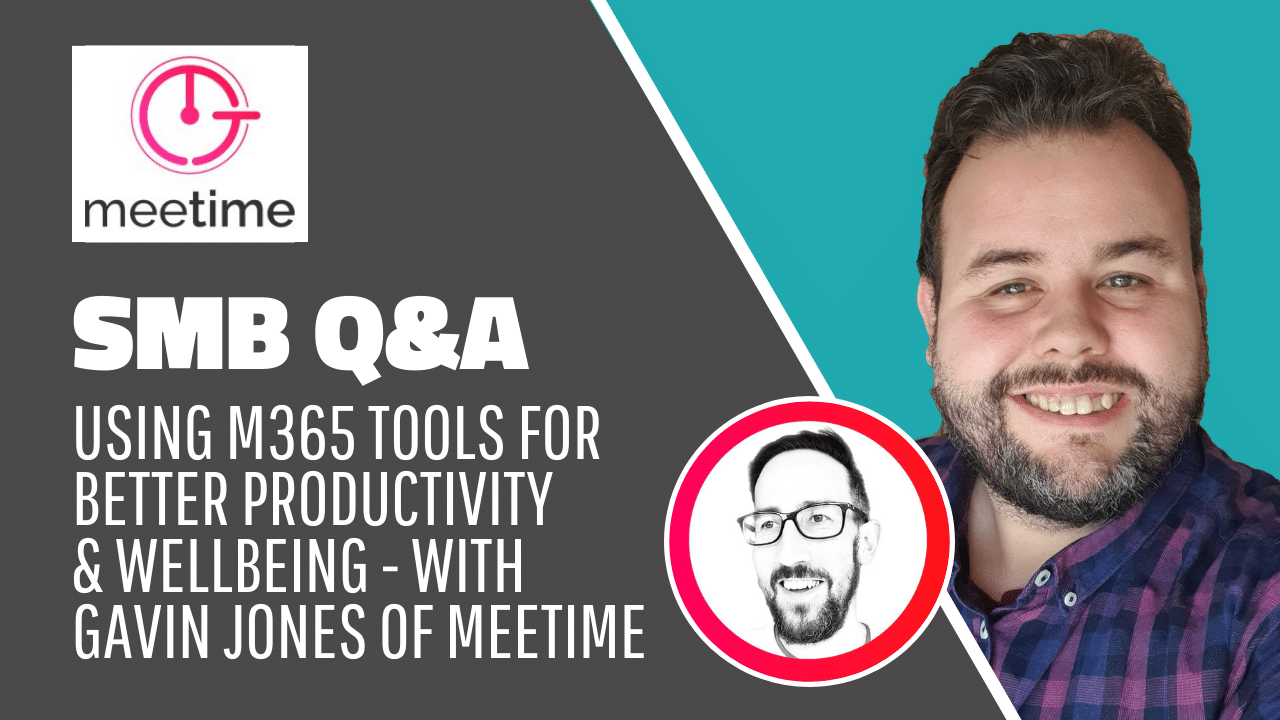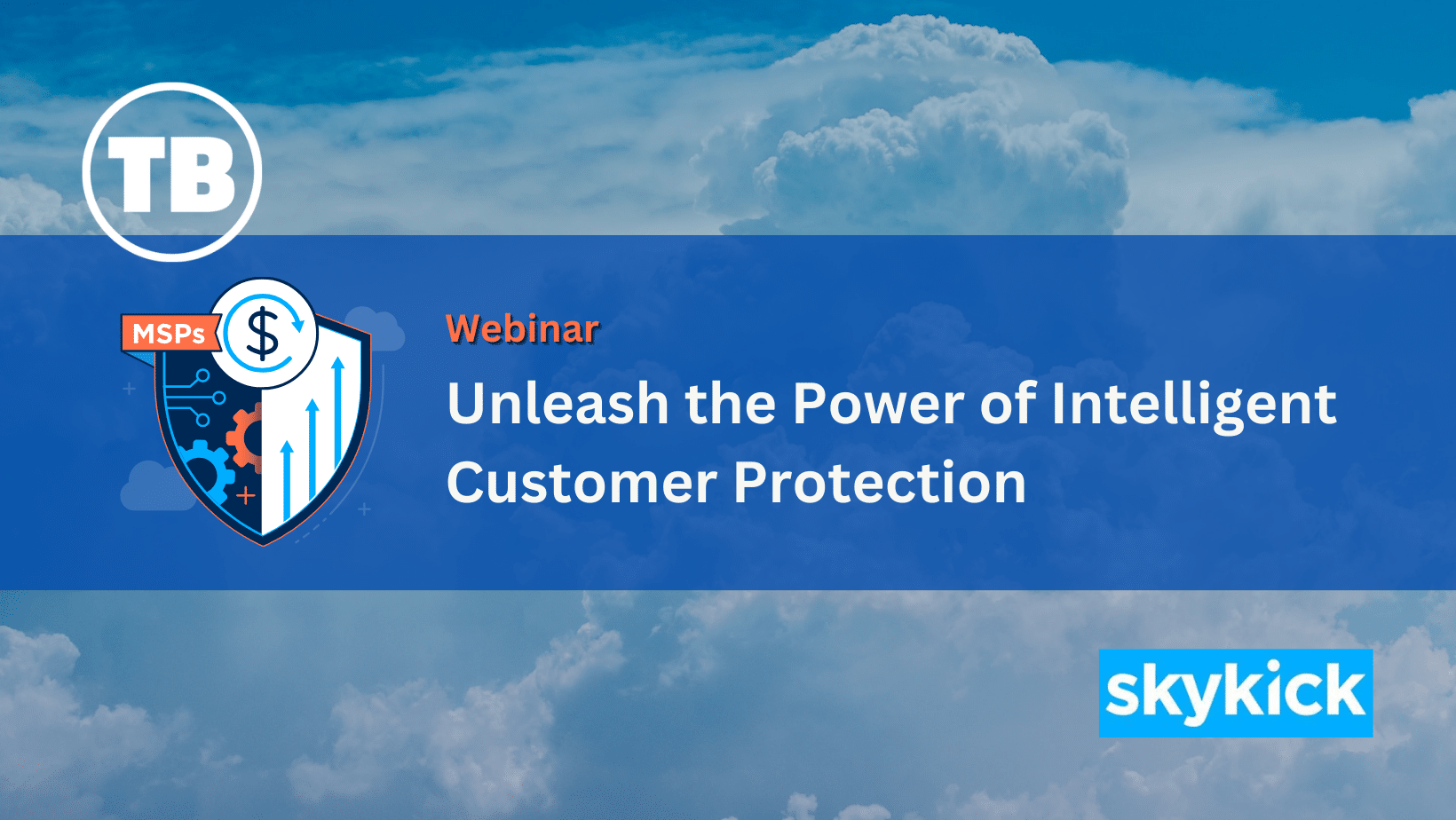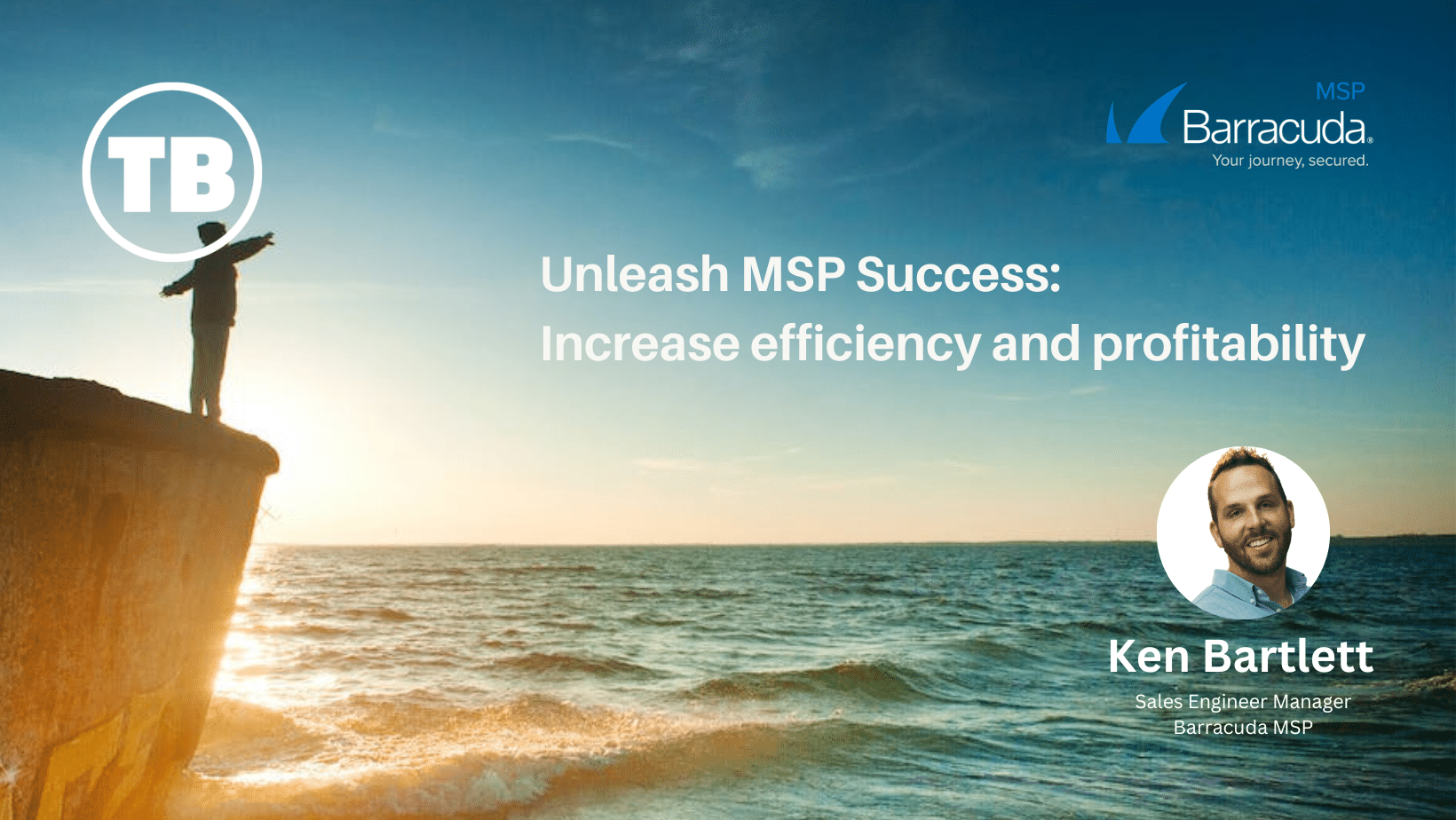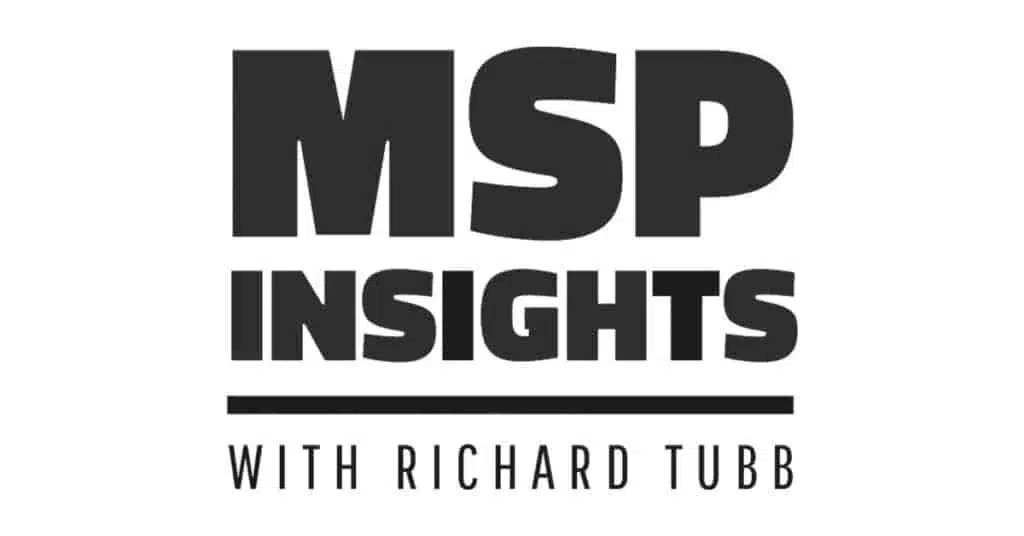There is an old phrase “What can be measured, can be managed”. Managed Service Providers (MSP’s) would be wise to create metrics within their business to measure themselves against – but should these Key Performance Indicators (KPI’s) be measuring your businesses financial performance, Service Delivery or something else?
Eric Dosal is the CEO of Brightgauge, an tool that helps IT Solution Providers to measure and manage their business. Dosal has recently joined Brightgauge full-time after brokering the sale of his families MSP business, Florida based Compuquip, to Konica Minolta.
I chatted with Eric to discuss his background and the family business, and to talk about the metrics that should matter to MSP’s – with some surprising insights.
Do you want to know the MSP metrics that matter? Then watch (or listen to the audio only, if you prefer) to my chat with Eric Dosal, or check out the transcript of our interview below!
https://soundcloud.com/tubblog/podcast-interview-with-eric
 You can find Eric Dosal on Twitter and Eric has very kindly also created a short white paper with more details on the points we covered in our discussion. You can download “Internal Metrics That Matter For MSPs” Whitepaper for free.
You can find Eric Dosal on Twitter and Eric has very kindly also created a short white paper with more details on the points we covered in our discussion. You can download “Internal Metrics That Matter For MSPs” Whitepaper for free.
TECHNICAL NOTE: If you’re having problems listening to audio here, disable any Ad-Blockers and make sure you have the latest version of Adobe Flash. If you’d like to download an MP3 audio copy of this interview to listen to away from your keyboard, then click the download button above or visit http://snd.sc/12OIFZh
Interview Transcript
Richard: Hello everybody. Richard Tubb here with an interview and I’m joined today by entrepreneur Eric Dosal. Eric is a second generation entrepreneur having worked on Wall Street before joining the family business at Miami based MSP called Compuquip. It was founded it in the 1980s by his mother and father. Now late in 2012, Eric helped broker the sale of Compuquip’s Managed Services division to Konica Minolta and has recently announced his return to join his brother, Brian at BrightGauge Software. Founded in 2010, BrightGauge has really quickly established a fantastic reputation for addressing the needs and providing real time analytics and reporting to IT manage service providers. Eric has very kindly agreed to share his time with me today to discuss MSP, analytics and reporting. So Eric, thank you for joining me.
Eric: Thank you, Richard. I really appreciate the invite. I wish we could do this in person, but we’ll settle for a little Google Hangout this time. But next time, I’ll take you up on a personal interview.
Richard: I look forward to it. It’s fair to say that’s quite a family background you’ve got there. It seems like business success runs through the Dosal family from your parents to you and, of course, to your brother. So tell me a little bit more about your background and the family background.
Eric: Sure. My father was a fourth generation in his family and he decided to leave that business, he saw an opportunity in the IT space. Back then in the 1980s, IT was just in its infancy. So he was doing mainframe maintenance; so he would buy used equipment, resell it and he just always had that entrepreneurial blood running through him. He always wanted us to be in the family business, so for 20 years, he ran it and it was just a straight IT services, IT support company always focusing on the customer, and then after a couple of years working out on Wall Street and getting burnt out from all those long hours and lack of sleep and all that stuff. I decided to come back and join the family business and started when it was just a small, 35 person shop doing about $6 million to $7 million in revenue; only doing time and material stuff. And over the last 10 or I guess 11 years now, we’ve really branched out into several different businesses. So it’s really exciting.
Richard: And because your brother is at BrightGauge there, and you’re rejoining the business now after the sale of the MSP division to Konica Minolta. So tell me what your role there at BrightGauge is going to be and tell us a little bit more about BrightGauge as a business.
Eric: Sure. My brother-, Compuquip actually has two divisions and we sold the MSP practice. What’s left now is our IT security services group and that’s run here in the southeast of the US, but our MSP practice, right before we were looking to sell, we really had a challenge with reporting for our clients. My brother ran sales, I ran service, and every time we wanted to run a report to send something to our clients, I needed a technical resource to pull the information out of the different systems. So he’s the one who came up with the idea there’s got to be a simple way to report. So he went to work on it, it was actually over the holidays in 2009, and came up with the first mock up – so pulling independent information from different databases that every MSP out there is using. Typically your PSA and your RMM, and then providing a nice, easy way to consolidate and send it out to your clients. He came up with that idea, he left in 2011, and then after we did the sale of our MSP practice, I joined the company. My focus is really on sales and marketing; and because it’s a global company, it’s a brand new thing.
I mean, here we are; you and I are having a conversation talking about BrightGauge when typically, I would sell to just customers that I could drive and see. So the global nature of this is phenomenal and Brian needed my help on the sales aspect so he could focus on the product development and so forth.
Richard: I had the opportunity to spend some time with you; I think it was last year, wasn’t it? In Florida at Autotask Community Live, if memory serves. I’ve been aware of BrightGauge for a couple of years; probably before you had too much of a presence here in the UK. So it’s fascinating to see you grow as a business and the product is really flourishing at this stage, isn’t it?
Eric: Yeah, so what’s been really exciting is we have clients on six continents and the growth, because everything is done online, it’s all web based, hosted, it’s pretty simple to install, and so our clients are all over the world. We have a big presence, obviously, in the US. The UK is probably our second largest and then Australia. Obviously, tying in to the English speaking languages is a big thing. We are looking at translating the software later on this year, but it’s amazing the adoption that we’ve had and really being able to bridge outside of the US and really get to know some of our partners outside in other countries.
Richard: I guess MSP metrics, analyzing your MSP metrics is the same regardless of whatever country you’re in. So let’s turn the focus a little bit towards MSP metrics. There’s an old phrase that I’m quite fond of ‘what can be measured can be managed’ which I know you’re very familiar with yourself. Why is it important for MSPs to analyze their business and build metrics that they can measure around?
Eric: I have a real passion for metrics, as geeky as that may sound. And what I’ve found in running the different businesses, especially within my family, they’re all different sized businesses and different types, but it really comes down to some basic fundamentals. That if you put the right metrics in place, it enables you to view how your business is doing in a real time view and then manage to improve it.
One of the nice things about having metrics, especially in the MSP business, is you grow the business and start with one person or two people, very easy for each of you to talk about: Where exactly are we? How are we performing? But as the business grows and maybe you have employees in other offices, maybe even other countries, how do you share the performance and how do you manage that they’re doing the right things in order to improve your performance?
So metrics to me is extremely important; one of the challenges I see is a lot of people who get excited about all of these different metrics and they have 100 different things they want to look at. I try to simplify that and I have an approach that’s worked for me in that what I do is try to first baseline the metrics; what is the information I’m looking for? And try to break those into different categories. So as a business owner, my main areas are really financial, service operation, service delivery, and then the sales and marketing. And then from there, drill down into specific metrics within those groups.
Richard: And I know that most MSPs I speak to when they talk about metrics, they initially focus on service delivery, so the doing of the business. We’ll come to service delivery in a minute if we may, but I want to, given your background in sales and marketing, if we could focus initially on the sales and marketing metrics, what would you say are the metrics that MSPs can measure around sales and marketing to help them grow their business?
Eric: That’s a great question. A lot of people tend to, especially technical folks in the MSP world; they tend to focus on the service delivery which is extremely important, but without sales, there not really a lot of service to deliver. And this is always that what came first, the chicken or the egg? And my brother and I always have that battle. I ran service, he ran sales. He said without him, we couldn’t do anything. I said without me, we couldn’t do anything, so we found a way to work together on that. But on the sales side, what I’ve found is that really understanding the type of revenue was probably one of our most important metrics. And we would divide them into buckets so we would have hardware/software, anything that we would resell would be divided into that group. Monthly recurring revenue; everyone has a different name for it whether it’s ‘managed services’ or ‘total care’, whatever the case may be – but anything that has a monthly contract around it. Then all the other types of services; professional services, integration, project break fix – all those types of things. And then I always had ‘other’. That is important because when you’re looking at metrics, a lot of people take, for example, vendor rebates, shipping and handling, all these types of things and bundle them into other line items. I like to see my revenue clean. What’s the hardware and software I’m driving? What’s the project revenue? Then try to correlate those. And this over time is very easy, but from a sales standpoint, I want to understand what sales they’re coming in, what buckets they’re coming in. So that’s historical.
Now what’s predictive? What’s going forward? That’s when we looked at the sales pipeline and every Monday morning I’d meet with my sales team, probably like thousands of other MSPs, let’s review our pipeline. And what I really wanted to understand was the type of revenue that was coming in. The timing of the revenue, that was always kind of up in the air because at the end of the day, we’re not a manufacturer who can provide a discount, we’re not going to strong arm our clients to bring in a deal. So we were really focused on what type of revenue was coming in and what can we do to move it up? And the way I looked at it was total revenue and I just had a weighted percentage based on where it is in the funnel.
That over time gave me an idea that if I knew that I had $200,000 in total contracts in the pipeline, I knew that over the next six months, I would close X. So it wasn’t an exact metric that this is going to happen on this day or that day, but it gave me an idea. So I started to get what I call “the pulse of my business” and the sales and marketing is a big piece of it.
I will tell you, one of my other passions is marketing. And doing marketing online, Twitter, Google Plus, whatever you call it, I find that MSPs in general tend to shy away from it with the case that who wants to listen to me? Why would anyone care? And sure, there are a bunch of millions of people on the internet who aren’t going to care about what you say.
However, the people who do care and are interested, they will find you. That’s the beauty of the internet. So I was a big proponent in that marketing aspect. And it took winning my first deal on a Facebook post that really opened my eyes to people actually read this stuff. And at the end of the day, it’s a social environment. They want to do business with people they know. So we used to monitor not only the sales and pipeline. But on the marketing side, we’d look at unique visitors to our website, how many blogs people were reading, then we would send out every week blog summaries to our clients and we would track which blogs people are opening because each of the blogs had a particular purpose. That would tie back to the type of revenue. Whether it’s a project, whether it’s a monthly recurring services, back up or whatever the occasion would be. So it’s definitely an important area.
Richard: That is fascinating to hear because as you’ve already mentioned, I see a lot of MSPs that I think are missing a huge trick by not getting involved in social media. Yet, these are the same businesses that come along to in person networking events and a spend lots of time there. It’s easy for them then to say ‘I met this person at this networking event, we ended up doing business’ and make the direct correlation. I think a lot of MSPs shy away from social media because they struggle to make that direct correlation. And of course it’s the same as perhaps PR or any advertising any of these activities. It can be a little bit more difficult, but what you’ve said there makes a lot of sense for sort of tracking social media activities to the resulting business.
Eric: Yeah. And when we had our first marketing campaign, the person who gave our presentation said ‘We’re going to spend a ton of money on marketing.’ It’s a famous quote and I don’t know who said it, but the woman said ‘50% of your marketing will work; I just don’t know which 50%.’ So it opened my eyes. Another story that kind of sticks out, and I always like to tie into personal experience, another one that sticks out is we used to take videos of our team doing different things and we did a triathlon a couple of years ago, we had a client who went onto our website, we had the video right there. He signed up within a couple of weeks and we didn’t have to explain the background of our business or what type of company we were. When I asked him how he found us, he said ‘I saw your video and I knew you had over 20 people on your team, you’re fun to work with, you all work as a team together, you’re supporting a good cause…’ and right there, for probably a half hour of work putting a video together, we were able to help land a new client.
Richard: Yeah. I think it helps build trust in you from afar. Lots of people do that research on companies without you ever knowing about it. Of course, they might find good things, they might find bad things, but they’re going to find something about you, so it’s much better off you putting out the culture of your business for people and you’ll attract like-minded people. It goes back to something you said earlier; people do business with people they like. If you give them the opportunity to find you and to like you, you’re going to pick up business that way.
So let’s switch gears a minute then. Let’s go back to service delivery metrics. This is where I first came across BrightGauge as some of the metrics you produce on your dashboard around that. So tell me your thoughts on the service delivery metrics that are really important for an MSP to be tracking. Isn’t there a danger they could get overwhelmed with too many metrics? What should they be focusing on?
Eric: In my experience, there is a ton of metrics that you can focus on, especially in service delivery. Most of MSPs like we talked about earlier will flock to the service delivery because it’s the area they feel most comfortable with. I’ll tell you that service delivery is extremely important; at the end of the day, if you’re not delivering a quality service to your clients, you are not going to have clients very long term. And when move into a monthly recurring model as an MSP, you want to make sure that those clients are happy all the time. So when I started to do metrics, and really, metrics for me started in 2009. I had signed two years prior a very large client spending about $35,000 per month with us, and after the two year renewal, they left us. And it’s because we were delivering a poor service. I was focused on the profit. How much money can I make on these guys? I wasn’t focused on the service that they were experiencing.
If anyone has ever walked into an Apple store, when you walk in, that experience that you get when you walk in, you’re excited to be there, everyone is bubbly and you feel like you’re going to buy something even though you may not need it. That’s the type of experience we try to bring to our client base, so the way we approached it was I actually sat with my team in a room and I said, ‘What are the important things we want to measure?’ We want to measure how happy our clients are, so that’s where we got our customer satisfaction. We want to make sure that we’re meeting the SLAs that we have promised within our contract, whether they’re actual promises or just general targets, we want to make sure that we live up to that. Then we started looking at what are the clients that are causing the most noise? That’s a big distraction, so which clients are opening the most tickets? And which one of my engineers is working the hardest to deliver all those things? So we looked at top ticket closer. Now, that’s not a direct correlation, obviously, if you have someone who closes 30 password resets versus one major issue, but you start to get a sense on who your top ticket closers are, what accounts are they working on? Which accounts are the one creating all this noise? And then on the other end, from a customer satisfaction, how are your surveys? How are people providing that feedback factor? In my opinion, the earlier you can find out about an issue and address it, the better. And even if there is an issue, that moment of when you connect with a client and say ‘I’m sorry, I’m going to fix this’, that’s an opportunity to build trust, even more trust. And let them know that you’re transparent. So our top metrics that we used to look at, top ticket closer for the team; that also will help not only to understand the team members, but it kind of motivated the guys about who was going to close more tickets. Top ticket closer, top clients from a ticket standpoint; we also tried to aggregate where we spent the majority of our time. One of our clients we ended up firing in 2010, I believe they were about 3 – 4% of our revenue, but 40% of the time. An account like that, no matter how great they are, will drain you. It’ll kill you. So between service level agreements and customer satisfaction, those will be the key ones. That’s five in there that you can manage through the team; share it with everybody and everyone will understand what they need to do to move forward.
Richard: Absolutely. I think the story you’ve just told about, first of all, the client that you unfortunately lost because you weren’t keeping track of how satisfied they were with the service. And secondly, the story that you shared about the client who was sucking up all your resources basically and not providing very much in return for it. I think it’s the fundamentals of metrics isn’t it? And what we said earlier, what can be measured can be managed. If you’re measuring these things, you’re able to make fact based decisions on what’s happening as opposed to going on gut feeling. A lot of MSPs work on gut feeling alone and sometimes, it just doesn’t show the whole story, does it?
Eric: Yeah. And you bring up a great point. The way I would approach metrics, I alluded to it a little bit earlier, I try to figure out, so let’s go with service delivery, those five metrics. The first thing I do is I start measuring those. I didn’t do anything with it, I just started measuring and getting that pulse. Then I try to figure out, let’s take, for example, SLAs. We guaranteed 30 minute SLAs on response times and let’s say right now we’re at 45 minutes. So my goal is now to get under 30 minutes. So now I have my baseline. I have my goal. So now I’ve started to experiment with what actions I can take and my team can take to adjust those. So we went from 45 to 28 and I knew the actions now.
Those were the goals that I set for my team; not so much about the SLA because everyone likes to know that they’re impacting SLA and they know that they need to get better, but what I’ve found is that the person on the front line doesn’t necessarily correlate what they’re doing on a day to day to how that’s improving your metrics. So it’s key to understand the metrics and understand your goal and then what are the actions that would move that needle and hold your team accountable?
One of the things we have, and not everyone, I know, is somewhat of a challenge, we had an issue with customer satisfaction. We found what made it better was that my service delivery manager had to visit every client twice a year. Bring bagels in the morning and get that real pipeline of information. That took our customer satisfaction through the roof, so that was the action, that was what he was motivated by, that’s what his incentive was based on, and at the end of the day, our metrics were in line with what we wanted them to be.
Richard: Very cool. I think we’ve both been in positions as owners of MSPs, and it’s easy to get overwhelmed by the amount of stuff you feel that you have to do. If you’re creating metrics and if you’re drilling down to the stuff that’s really important, it gives you that focus to take the right actions as opposed to going, ‘I don’t know where to start’, and consequently getting nothing done.
Eric: Yeah, and it can be extremely overwhelming. What I like to do is just start simple; I probably looked at ten to fifteen metrics every week. That was it. And what are the actions that were driving those? We had them laid out kind of like a pyramid so I knew that my service delivery manager had to go visit each client, so when I met with him, I just talked about client visits and made sure that he was managing that. Then I knew that my metric would be in the right zone. Then I would just manage by exception. Once you have those drilled down, then you manage instead of all the metrics, you just look for the yellows and the reds so you can address those.
Richard: Makes sense. Now, every MSP is in business to make money. Profitability is hugely important. We’re small, but there are plenty of MSPs who seem to be doing it for the love of helping clients. But you’ve got to make a profit for it to be sustainable. So tell me a little bit about, in your experience, what are the financial metrics that MSPs need to track?
Eric: Finance – near and dear to my heart. At the end of the day, cash is king. That’s something that my father ingrained in both my brother and I very early on. He actually used to wear a t-shirt that said ‘Happiness is a positive cash flow’. And we got a kick out of it. I didn’t really understand it until I got into business, but our number one financial metric that we would look at is cash on hand. Every day, we look at all the cash across all the different accounts and as small mom and pop shop as it might sound anything that is an operational expense; I’m the one who signs that check. So I review those checks every week, sign off on them. I ask questions if there are issues, if they’re out of balance. But before they get to me, someone is looking at whether they are legit and whether they’re within the norm of what we spend. So cash is important.
Accounts receivable is the other one. So you have cash coming in, but you want to make sure you’re collecting on it. So receivables we look at every week, and then any invoice that was over 60 days got daily attention. So one of the interesting things, and this is probably unique in our industry, is our sales people were not compensated on any transaction the customer paid over 90 days. So it pushed a little bit of the credit officer or credit research down to the sales level because if they sold it, they didn’t get it, then they wouldn’t get any commission on it. So those two metrics were really important from a cash standpoint.
Then we would drill down into service margin. We were very focused on what kind of margin we were getting for our services. Were we leveraging that Holy Grail of managed services where you just build a small team and the revenue just keeps coming in; your expenses stay flat, but your revenue goes through the roof. That we always monitored. Our goal was to get 60% gross margin on all of our monthly contracts.
In reality, I’d say the number was probably closer to the mid-40s and then our project management which was in the mid-60s. So at a blended rate, we were still around 50 which was nice. But we always had room to grow. Then our EBITDA margin which is the last measure we look, that’s one monthly. Most people look at things to make sure there’s enough profit going to the bottom line for evaluation purposes if you ever need a line of credit. All those financials are important and if you’re not looking at them, I’ve run into multiple MSPs as clients when we talk about metrics, that they don’t even close their books every month. So they’re closing their books maybe once a quarter or they need help; if you can get into the rhythm of closing the books every month and getting an idea of how your business is doing, again, that goes back to my original point of getting to the pulse of the organization, and you’ll learn that certain months are better than others because of a natural rhythm. In the States here, November is a slow month because of Thanksgiving and the holidays. February is also a slow month because it’s a short month. Those types of things help you prepare that maybe, ‘Hey if I have to put down a deposit for a particular investment or something, let me shift it around and not do it in November; maybe do it in December or January.’ But without measuring, it’s very difficult to make any decisions.
Richard: Absolutely. Much of the work that I do is coaching and consultancy with MSPs and one of the very first things that we tend to do once we start working together is to put in place a weekly financial report. It’s just a really simple document that shows money in the bank, how much money is owed, and how much money the business is owed by clients. And it’s amazing; once you start looking at those three really simple metrics, how much positive activity it drives within the business. If people are getting measured on it, then people are picking up the phone and ringing clients and saying ‘Hey, when are you going to pay these bills?’. You will find your relationships with vendors and suppliers become better because you tend to pay things on time and of course, the cash in the bank; all important. You’re not taken by surprise.
So it’s really simple to get those things in place. And just before we came on air Eric, you were showing me your white board. Just so we can see it’s in back of you there. So returning to probably the start of the conversation, we were saying there are basic metrics that MSPs can manage, but how do they avoid becoming overwhelmed with metrics? Is there a danger you can measure too much?
Eric: Yeah. If you will indulge me here, I have a little white board. Richard gave me about ten minutes head’s up on the specific topic on what we were going to cover, so if you can see that all right?
Richard: We can, yeah.
Eric: Okay great. What I did was is Richard gave me an idea on the different groups and how we’re going to discuss it, and it actually matched up perfectly with how I look at things – so financial, sales and marketing, and, of course, service operations. All these feed each other because without the financing, without the cash in the bank, you can’t pay for the majority of these things.
Sales and marketing needs to come in and deliver that for the clients so you can deliver service. What we found at Compuquip, and I’ll talk a little bit about this; I can always add more of this later and probably write a blog online, is about how people came up with the client efficiency index. It was one metric that combined everything into a way that we can share it with our clients. So this allowed us to report on how our clients are doing from a revenue standpoint, from a service delivery standpoint, and then as well from a profitability standpoint. And the premise of it is you take the total revenue of each of your monthly clients and you graph that out individually. You subtract all the costs associated with it, and then you subtract your fully loaded labor. At the end of the day, you’ll get a number. Let’s say for example you had been earning $1000. When you subtract all your costs of $600, you’re making $400 on a particular client. That’s a 40% gross margin. Now when you share that with a team member, they may not correlate 40% and they might say if they’re making 40%, why don’t I get paid 40% more? So you deal with those types of issues.
So I came up with this creative way. My target was 60% gross margin; I added 40% to it. So now my target is 100%. So every number at the end here just got 40% added to it. So in effect, that prior example of 40% margin, when you add the 40 to it, now it’s 80 score. And so I label it in the client efficiency index. That enabled me to share this with the entire company. Everyone could see how each of the companies of each of our clients is performing, and that they would know which clients need the attention. So we colored it, and I know this isn’t zoomed in; I’ll put some more detail on, but the red creating a problem, we’re losing money on it; the green are doing great. They’re making too much money and we’re probably not spending enough time on them. But again, it’s just one simple way for us to connect with our employees so they could understand a metric that made sense to them and that explained to them how they can adjust that metric.
Richard: And you hit on a very important point there and that’s simplicity. I think anybody who is watching this hang out here will understand that it’s important to measure so you can manage it properly. Lots of people get put off because they feel like it’s too much work to mine that data from within their business. All of which leads us really nicely into BrightGauge and the work that you’ve done as an organization to provide this single dashboard to provide information to MSPs. So tell us a little more about BrightGauge as a tool and how it can help MSPs.
Eric: Absolutely. BrightGauge originally started out as a client facing reporting tool. So all we would do is provide information for your clients. We built it for ourselves and in 2010 at one of our peer groups, HTG, they saw it and they said, ‘Hey, can we also take a look at that? I’d love to have that on our network and for us to report to our clients.’ So in 2011, we commercialized it and the first evolution was that client facing. But now, it’s like all this data is in there, I want access to it. And this is what all of our customers are telling us. So we said ‘Okay, no problem. What we’re going to do is we’re going to put the power of that customization and that data that you want to aggregate in your hands.’ So last summer, we released a custom gauge builder that will let you build your own gauges so you can mash the data from your different systems, put it together and report on it. The challenge has always been: How do I make that easy for the MSPs? Because everybody wants it a little bit differently. Some people might say I want to see SLAs over 30 days, 45, 90, whatever the case may be.
So we did another iteration of that and we’re releasing it this month in May and the goal is that now you’re going to be able to customize the information out of your different systems. Aggregate them in a way that makes sense for you, and not only report on it for your clients, but now you’ll be able to report on it internally. So you’ll be able to run those metrics. What are my SLAs across all my clients or a particular set of clients? And be able to say maybe there’s an individual that’s responsible for a particular team and a particular set of clients; here is the gauge that you’re going to monitor and make sure we are constantly in the green. And the dashboard release will be coming third quarter as well, but at the end of the day, what we want to build, and this is the original idea, is a real time platform to see how your business is performing and to be able to make decisions whether you’re in the office, on a beach in the UK, or wherever it is that you’re hanging out, we want you to be able to make those decisions with the information you have. It’s your data; it’s just a matter of pulling it out of the systems in an easy format.
Richard: Well I can assure you there aren’t going to be many people relaxing on the beach in the UK given the weather that we’ve got here at the moment. Which tools do you integrate? Lots of MSPs already have tools in place such as Autotask, ConnectWise, GFI Max here in the UK is the predominant tool, and do you integrate with these tools? How does that work?
Eric: Yeah. Right now we have an integration list that includes on the PSA side Autotask, Connectwise as well. And on the RMM side we’re integrating with Kaseya, with Labtech, and GFI. We are working on additional integrations so probably later on this year that will allow us to open up the market a bit more because more and more MSPs are really interested in it. At the end of the day, with the new version we’re releasing, our clients are really focused on the data that are coming out of their PSA and Autotask and Connectwise are rich with information. It’s just a matter of how can you view it in a way that makes sense for you?
Richard: Absolutely. We’re approaching the end of our time now, Eric. Thanks so much for joining me today. I could sit and talk to you all day on this subject because I think we’re both metrics geeks, it’d be fair to say. I really appreciate your time. But before we go, if anybody wants to reach out to you personally or to learn more about how BrightGauge can help their MSP, or just to talk metrics with you, how can they find you?
Eric: The easiest way, I’m going to put up a landing page for everyone to be able to come out and connect with me. http://Brightgauge.com/metrics. I’ll have that up in the next few days so that everyone can connect in. I’ll include some of the information that I’ve talked about here and some more details, you can download it, use it, and also in there, you’ll be able to connect with me via LinkedIn, Twitter, or email. And I can answer as many questions as you have.
Richard: Fantastic. Eric, really appreciate your time today. We must do it again really soon and hopefully we’ll catch up in person as well. Thanks for your time today, Eric. I appreciate it.
Eric: Thank you very much, Richard.
















Comments
3 thoughts on MSP Metrics That Matter – An Interview with Eric Dosal
BRIGHTGAUGE | INTERNAL METRICS THAT MATTER FOR MSPS | SEVERAL WEEKS AGO I CAUGHT UP WITH RICHARD TUBB WHO I’VE HAD THE PLEASURE OF GETTING TO KNOW OVER THE PAST SEVERAL YEARS. TYPICALLY, WE CONNECT WHEN WE EA
7TH MAY 2013 19:52:00
[...] Since we ran out of time during our initial discussion, we decided we needed to reconnect and do a much deeper dive into internal metrics for MSPs. You can watch the entire video here: MSP [...]
BRIGHTGAUGE | AUTOTASK COMMLIVE 2013 WRAP UP | ONCE AGAIN THE BRIGHTGAUGE TEAM WAS AT THE AUTOTASK COMMLIVE EVENT AND WE HAD A BLAST. THE LOCATION WAS AMAZING, ALTHOUGH A LITTLE WARM WITH TEMPERATURES
17TH JUNE 2013 16:53:12
[...] very near to my heart. We recently published a whitepaper on key Internal Metrics following my conversation with Richard Tubb from last month. I was happy to meet several people that had seen the video and enjoyed the white [...]
BRIGHTGAUGE | INTERNAL METRICS FOLLOW UP | I’VE BEEN HUMBLED WITH ALL THE FEEDBACK ON MY RECENT WHITEPAPER “INTERNAL METRICS THAT MATTER FOR MSPS”. WHAT STARTED OUT AS AN IDEA DURING A CONVERSATION
3RD JULY 2013 19:01:34
[...] on my recent whitepaper “Internal Metrics That Matter for MSPs”. What started out as an idea during a conversation with a my friend Richard Tubb, has really taken on a life of it’s own. After many requests I’ve decided to expand on the [...]